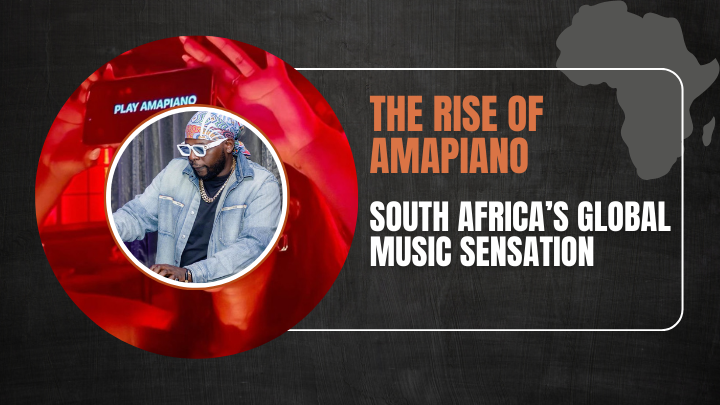Thee Rise of Amapiano
In recent years, a new wave of music has taken the world by storm—Amapiano. Originating from South Africa, this genre has quickly transformed into a global sensation, captivating audiences from Africa to the Americas, Europe, and beyond. Characterized by its infectious rhythms, smooth melodies, and deep house influences, Amapiano has firmly established itself as the sound of a new generation. But how did this genre rise to prominence, and what has made it so universally appealing? Let’s explore the origins of Amapiano, its worldwide influence, and some of the top artists shaping the genre today.
The Origins of Amapiano
Amapiano, which translates to "the pianos" in Zulu, first emerged in South Africa in the early 2010s. It is a fusion of multiple musical genres, blending elements of deep house, jazz, and kwaito (a South African style of electronic dance music). Its distinctive sound features catchy piano riffs, rolling basslines, and percussive rhythms, often accompanied by soulful melodies and vocal samples. These elements give Amapiano a smooth, laid-back yet infectious vibe that makes it perfect for both casual listening and high-energy dance floors.
The genre was born in the townships of South Africa, where young producers experimented with blending local sounds with international music influences. What began as an underground movement soon gained momentum, becoming a mainstream phenomenon that resonated with music lovers not only in South Africa but across Africa and the world.
The Global Appeal of Amapiano
What has made Amapiano so universally appealing? The genre’s ability to blend traditional African sounds with modern electronic beats has created a sound that is both nostalgic and futuristic. Its fusion of genres such as house music, jazz, and kwaito makes it versatile and accessible to a wide range of listeners.
Amapiano’s rise can also be attributed to the strong cultural identity it carries. The genre is rooted in South African life, with lyrics and themes often reflecting the experiences of young people in the townships, the pulse of African urban culture, and social commentary. Yet, despite these local influences, Amapiano’s deep, groove-heavy sound transcends borders and speaks to a global audience.
The genre’s infectious rhythms and repetitive piano riffs have made it particularly popular in nightclubs and dance parties worldwide. Amapiano’s smooth, mellow tempo is perfect for setting a laid-back vibe, but its uptempo versions also make it ideal for getting people to their feet and onto the dance floor. With its global appeal, the genre has become a driving force in the worldwide music scene.
Top Artists Behind the Amapiano Revolution
Several artists have played pivotal roles in taking Amapiano from its South African roots to the global stage. Among them, two names stand out: Kabza De Small and DJ Maphorisa, who are widely regarded as the architects of the genre’s rise.
Kabza De Small: The King of Amapiano
Kabza De Small, born in Mpumalanga, South Africa, is often referred to as the "King of Amapiano." His innovative approach to the genre has made him one of the most influential figures in the South African music scene. Kabza’s mastery of smooth, rolling piano riffs, deep basslines, and soulful melodies has helped define the Amapiano sound. He has released numerous albums and singles that have become anthems in the Amapiano community, and his collaborations with top artists have pushed the genre to new heights.
Kabza De Small’s work is known for its ability to blend danceability with emotional depth, combining catchy beats with thought-provoking lyricism. His music consistently tops charts in South Africa and across Africa, and his live performances have become legendary, drawing huge crowds to clubs, festivals, and events worldwide.
DJ Maphorisa: The Pioneer and Producer
DJ Maphorisa, born Themba Sekowe, is another key figure in the rise of Amapiano. Known for his skill as both a DJ and a producer, DJ Maphorisa has played a central role in shaping the sound of Amapiano through his collaborations with various artists. His partnership with Kabza De Small has produced some of the genre’s biggest hits, including Scorpion Kings and The Return of the Scorpion Kings albums, which have been major success stories in South Africa and internationally.
DJ Maphorisa’s ability to fuse Amapiano with other genres, including dancehall, Afrobeat, and hip-hop, has made his music highly versatile and widely appealing. His influence has extended beyond the Amapiano genre, as he has worked with a wide range of African and international artists, helping to shape the sound of African music as a whole.
Amapiano’s Influence Beyond South Africa
While Amapiano’s roots are firmly planted in South Africa, the genre’s influence has spread rapidly across the globe. In countries throughout Africa, Amapiano has become the soundtrack to youth culture, influencing everything from dance styles to fashion and social media trends. Countries like Nigeria, Kenya, and Zimbabwe have embraced Amapiano, with artists from these regions incorporating the genre’s distinct rhythms into their own music.
The genre has also made its mark internationally, with artists and DJs from Europe, the United States, and other parts of the world incorporating Amapiano into their sets. This cross-cultural exchange has helped Amapiano gain recognition as one of the most exciting and innovative music genres to emerge from Africa in recent years.
Amapiano has even garnered attention from global streaming platforms like Spotify and Apple Music, with dedicated playlists showcasing the genre to a wider audience. As more listeners discover the genre’s infectious rhythms and energetic beats, Amapiano’s reach continues to grow, making it one of the most influential musical movements of the decade.
What’s Next for Amapiano?
In 2025, Amapiano is expected to continue its global rise, with new artists and producers adding fresh sounds to the genre. As Amapiano evolves, expect to see even more fusion with other genres, as artists experiment with different influences and styles. The genre’s ability to adapt and evolve while maintaining its distinct South African identity will likely be key to its continued success.
For fans of the genre, the future looks bright, with Kabza De Small, DJ Maphorisa, and other rising stars continuing to push the boundaries of what Amapiano can be. Whether you’re a longtime fan or just discovering the genre, Amapiano’s infectious beats and captivating melodies are sure to keep you coming back for more.
Amapiano is not just a genre of music; it’s a cultural movement that has reshaped the African music landscape. From its humble beginnings in the South African townships to its worldwide success, Amapiano has captured the hearts of music lovers everywhere. With its distinctive sound, its ability to bring people together, and its rich cultural roots, Amapiano is here to stay—making 2025 and beyond the perfect time to add this global music sensation to your playlist.



